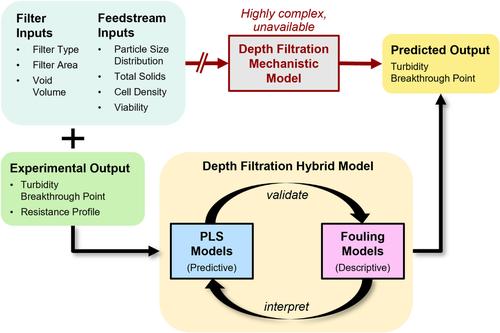当前位置:
X-MOL 学术
›
Biotechnol. Bioeng.
›
论文详情
Our official English website, www.x-mol.net, welcomes your feedback! (Note: you will need to create a separate account there.)
Combining descriptive and predictive modeling to systematically design depth filtration-based harvest processes for biologics
Biotechnology and Bioengineering ( IF 3.5 ) Pub Date : 2024-06-04 , DOI: 10.1002/bit.28765 Peter Liu 1 , Michael Hartmann 2 , Ajay Shankaran 1 , Hong Li 1 , John Welsh 1
Biotechnology and Bioengineering ( IF 3.5 ) Pub Date : 2024-06-04 , DOI: 10.1002/bit.28765 Peter Liu 1 , Michael Hartmann 2 , Ajay Shankaran 1 , Hong Li 1 , John Welsh 1
Affiliation

|
Advances in upstream production of biologics–particularly intensified fed-batch processes beyond 10% cell solids–have severely strained harvest operations, especially depth filtration. Bioreactors containing high amounts of cell debris (more than 40% particles <10 µm in diameter) are increasingly common and drive the need for more robust depth filtration processes, while accelerated timelines emphasize the need for predictive tools to accelerate development. Both needs are constrained by the current limited mechanistic understanding of the harvest filter-feedstream system. Historically, process development relied on screening scale-down depth filter devices and conditions to define throughput before fouling, indicated by increasing differential pressure and/or particle breakthrough (measured via turbidity). This approach is straightforward, but resource-intensive, and its results are inherently limited by the variability of the feedstream. Semi-empirical models have been developed from first principles to describe various mechanisms of filter fouling, that is, pore constriction, pore blocking, and/or surface deposit. Fitting these models to experimental data can assist in identifying the dominant fouling mechanism. Still, this approach sees limited application to guide process development, as it is descriptive, not predictive. To address this gap, we developed a hybrid modeling approach. Leveraging historical bench scale filtration process data, we built a partial least squares regression model to predict particle breakthrough from filter and feedstream attributes, and leveraged the model to demonstrate prediction of filter performance a priori. The fouling models are used to interpret and provide physical meaning to these computational models. This hybrid approach–combining the mechanistic insights of fouling models and the predictive capability of computational models–was used to establish a robust platform strategy for depth filtration of Chinese hamster ovary cell cultures. As new data continues to teach the computational models, in silico tools will become an essential part of harvest process development by enabling prospective experimental design, reducing total experimental load, and accelerating development under strict timelines.
中文翻译:

结合描述性和预测性模型,系统地设计基于深度过滤的生物制剂收获工艺
生物制品上游生产的进步,特别是超过 10% 细胞固体的强化分批补料工艺,给收获操作带来了严重压力,尤其是深度过滤。含有大量细胞碎片(计算机工具中超过 40% 的颗粒 <10 id=24>)的生物反应器将成为收获过程开发的重要组成部分,因为它可以实现前瞻性实验设计、减少总实验负荷并在严格的时间表下加速开发。
更新日期:2024-06-04
中文翻译:

结合描述性和预测性模型,系统地设计基于深度过滤的生物制剂收获工艺
生物制品上游生产的进步,特别是超过 10% 细胞固体的强化分批补料工艺,给收获操作带来了严重压力,尤其是深度过滤。含有大量细胞碎片(计算机工具中超过 40% 的颗粒 <10 id=24>)的生物反应器将成为收获过程开发的重要组成部分,因为它可以实现前瞻性实验设计、减少总实验负荷并在严格的时间表下加速开发。
















































 京公网安备 11010802027423号
京公网安备 11010802027423号